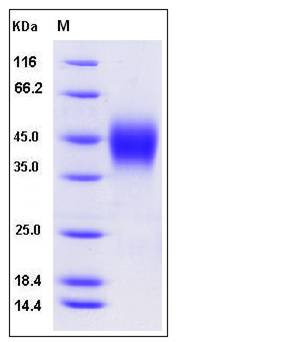Mouse IFNGR1 / CD119 Protein (His Tag)
CD119,Ifgr,IFN-gammaR,Ifngr,Nktar
- 100ug (NPP3359) Please inquiry
| Catalog Number | P50705-M08H |
|---|---|
| Organism Species | Mouse |
| Host | Human Cells |
| Synonyms | CD119,Ifgr,IFN-gammaR,Ifngr,Nktar |
| Molecular Weight | The recombinant mouse IFNGR1 consists of 242 amino acids and has a predicted molecular mass of 27.4 kDa. In SDS-PAGE under reducing conditions, the apparent molecular mass of rmIFNGR1 is approximately 40-45 kDa due to glycosylation. |
| predicted N | Gly 23 |
| SDS-PAGE |  |
| Purity | > 98 % as determined by SDS-PAGE |
| Protein Construction | A DNA sequence encoding the mouse IFNGR1 (P15261) extracellular domain (Met 1-Asp 253) was expressed, with a polyhistidine tag at the C-terminus. |
| Bio-activity | Measured by its ability to bind with recombinant mouse IFNG-Fc (P50709-M02H) in a functional ELISA. |
| Research Area | Cardiovascular |Angiogenesis |Cytokine & Receptor |Interferon & Receptor |Interferon receptor |
| Formulation | Lyophilized from sterile PBS, pH 7.4 1. Normally 5 % - 8 % trehalose and mannitol are added as protectants before lyophilization. Specific concentrations are included in the hardcopy of COA. |
| Background | The cluster of differentiation (CD) system is commonly used as cell markers in immunophynotyping. Different kinds of cells in the immune system can be identified through the surface CD molecules which associating with the immune function of the cell. There are more than 320 CD unique clusters and subclusters have been identified. Some of the CD molecules serve as receptors or ligands important to the cell through initiating a signal cascade which then alter the behavior of the cell. Some CD proteins do not take part in cell signal process but have other functions such as cell adhesion. CD119 (cluster of differentiation 119), also known as IFNGR1 ( interferon gamma receptor 1), is part of the heterodimeric gamma interferon receptor which consists of IFNGR1 (CD119) and IFNGR2. The IFNGR1 gene encodes the ligand-binding chain (alpha) of the interteron receptor while IFNGR gene encodes the non-ligand binding partner. The ability of the interferon-γ was achieved through binding to the interferon receptor CD119. After binding, the products of activated T-lymphocytes interferon-γ exerts antiviral activity, growth inhibitory effect, and several immune- regulatory activities on a variety of cell types. |
| Reference |
